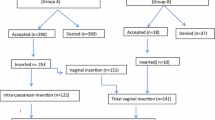Abstract
Background
This study examines to describe the factors associated with acceptability of immediate PPIUCD insertion in women according to their socio-demographic and obstetrics characteristics, and future pregnancy desires and to determine the rates of uterine perforation, expulsion, pelvic infection, lost strings and displacement following PPIUCD insertion among the acceptors by 6 to 18 months.
Aim
An intrauterine device (IUD) is an effective form of Long Acting Reversible Contraception. Present study is aimed at determining the safety, efficacy, and expulsion of Post-placental and intra-cesarean insertion of Intrauterine contraceptive device (PPIUCD).
Materials & Methods
The study was conducted at District Head Quarters Hospital, Bolangir, Odisha, India. From 1st. January 2012 to 31st. December 2012. Women admitted and delivered at D.H.H. Bolangir, were counseled. CuT 380A was inserted within 10 minutes of delivery of placenta in accepters who fulfilled the Medical Eligibility Criteria and had no contraindications for PPIUCD. They were followed up till 30th June 2013.
Results
Total women counseled 3209, Accepted 564, Declined 2645, lost to follow up 130, Followed up 434, Complications: 190 (Expulsion 39, Bleeding 102, String problem 49), Removal 43, Continuation 352.
Conclusions
The PPIUCD (Inserting CuT 380 A by 10 minutes after placental delivery) was demonstrably safe, effective, has high retention rate. The expulsion rate was not very high and it can be reduced with practice. With the high level of acceptance despite low levels of awareness, the government needs to develop strategies to increase public awareness of the PPIUCD through different media sources. It is also important to arrange training on PPIUCD in order to increase knowledge and skills among healthcare providers. This will also further promote PPIUCD use and aid in reduction of the expulsion rates. Cash incentives to the accepter, motivator and of course provider would bring about a substantial progress in the PPIUCD use in developing countries like India.

Similar content being viewed by others
References
Safwat A, Mohamed Momen A, Kamel Omar M, et al. Acceptability for the use of postpartum intrauterine contraceptive devices: assiut experience. Med Princ Pract. 2003;12:170–5.
Thomas D, Maluccio J. Fertility, contraceptive choice, and public policy in Zimbabwe. World Bank Econ Rev. 1996;10(1):189–222.
Grimes D, Schulz K, van Vliet H, et al. Immediate post-partum insertion of intrauterine devices: a cochrane review. Hum Reprod. 2002;17(3):549–54.
Maternal and Child Health Integrated Program and PPFP activities, WHO Report. http://www.k4health.org/sites/default/files/PPFPMeetingReport_formatted.pdf.
Celen S, Moroy P, Sucak A, et al. Clinical outcomes of early post placental insertion of intrauterine contraceptive devices. Contraception. 2004;69:279–82.
Blanchard H, Mac Kaig C. ACCESS-FP Program. 2006. Postpartum contraception: http://www.k4health.org/sites/default/files/postpartumabortion_English.pdf.
Tatum HJ, Beltran RS, Ramos R, et al. Immediate post placental insertion of GYNE-T 380 and GYNE-T 380 postpartum contraceptive devices: randomized study. Am J Obstet Gynecol. 1996;175(5):1231–5 Family planning methods and birth spacing after childbirth. Power point Presentation.
Author information
Authors and Affiliations
Corresponding author
Rights and permissions
About this article
Cite this article
Mishra, S. Evaluation of Safety, Efficacy, and Expulsion of Post-Placental and Intra-Cesarean Insertion of Intrauterine Contraceptive Devices (PPIUCD). J Obstet Gynecol India 64, 337–343 (2014). https://doi.org/10.1007/s13224-014-0550-3
Received:
Accepted:
Published:
Issue Date:
DOI: https://doi.org/10.1007/s13224-014-0550-3




